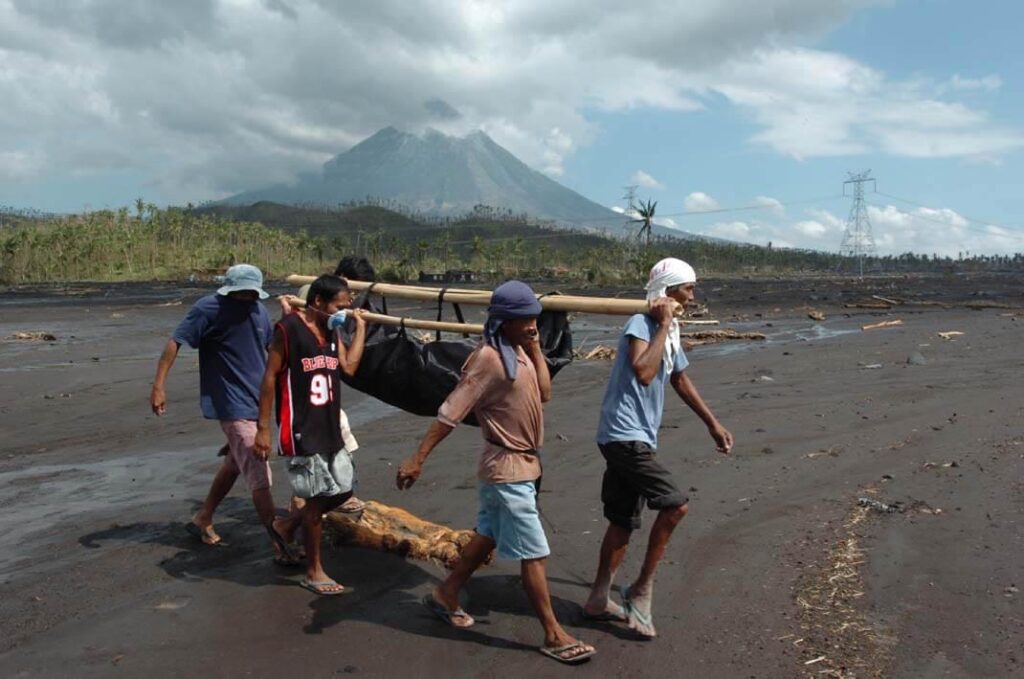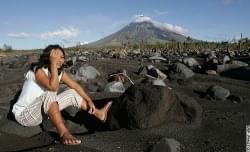By Abdon M. Balde Jr.
(Typhoon Reming hit Albay in November 30, 2006. Barely a month after, I trekked the devastated land on Innocents Day, December 28 and wrote this article which was published in Philippine Graphics Magazine a few months later.)
I was on the sands of Cagsawa the morning of December 28, 2006 thinking, it’s Innocents Day, if I borrow money I would not be forced to pay it. Something to do with the thousands of innocent children slaughtered in Israel to ensure that the infant Jesus is dead. The connection is never clear to me, but anyway, if you are caught unaware, you lend money, you better not expect to get it back.
There was a house without walls on the way, only columns and tegula roofing sticking on the sand. A foot thick of sand has covered the floor. I followed the procession of people going down by the side of the house in the sand to a shallow stream spanned by a makeshift bridge of half a trunk of coconut not more than two meters long. In the middle of the bridge, I looked back and saw the house in the sand was actually two stories, the first floor buried, its wide windows suffocated by sand.
After crossing two more makeshift bridges, I was in the middle of the vast sand with huge boulders strewn everywhere. Some boulders were the size of an Isuzu Elf or a Mitsubishi Canter. Between the boulders were the occasional rooftops with the galvanized iron ridge sticking out of the sand like a pyramid, an upturned boat, a strange dike, many in unnatural angles, all gleaming in the pale sunlight. These are the remains of the few big, sturdy houses, those with concrete foundations and hollow block walls. The countless small, wooden houses are all gone, not a trace of them left in the sand. Uprooted from its footings, swept away, rolled over, tossed and hurled on the sides of the rugged hills and dumped into the sea six or seven kilometers away. Many of the occupants were inside, shocked and witless, when the houses were swept away at an hour or so past noon of November 30—men, women, the aged and the children, many of them were last seen bobbing up and down the brown rampaging stream with those murderous boulders, their mouths wide open, screaming silently, dread in their eyes, their hands flailing hopelessly. Some witnesses were unsure if the people in their houses or in the water were pleading for help or waving goodbye.
Not far away, I could see through the zoom lens of my camera, pointed at the road winding the hills of Daraga, the carcasses of houses and other structures sticking out of the sand: shuttered rafters, broken posts, pieces of roofing, badly deformed iron gates and window grills, broken trunks of big trees, two blue ten-wheeler trucks crumpled like soap boxes near a big factory buried to its rafters, pieces of concrete blocks and a jumble of lumber yanked out of houses no longer there. Looking at the extensive devastation of what were once a line of villages as far as the eye could see, I could almost hear the groans and the wailings of people who were brutally swept away. But the sounds were only in my mind. The real sounds around me came from the dull murmur of shallow streams and the sighs of people awed by the dreary landscape.
I could feel in my ears the easterly wind but it’s mute this morning. It moved sluggishly past us like a horde of reluctant ghosts responding to an unwanted summon. As mute as Mayon, its huge perfect cone looming over us like a sleepy giant sapped of vigor after too much work. I looked up the summit of the volcano and saw the black streaks of volcanic ash and boulders hanging on the perfect slopes, tens of millions of tons of debris still up there deposited by over six months of intermittent eruptions, just waiting for rain to give it a slight shove, a nudge, so it would run down to where we were. A few days ago just over a million tons streaked down the deep gullies and ravines down to where I was standing, and I shuddered at the thought that if it rains and anything moves up there, it will hit me before I could run back to the side of the road where my van was parked.
Not more than two meters of the old spillway was left intact, the rest buried in the sand, a small stream now overflowing. As I went up the old road, I saw the 1814 Restaurant on my right in complete mess, Jesus, its anahaw roofing torn everywhere, the bamboo posts leaning in different directions, the sawali and nipa sidings brutally frayed. On the left, only pieces of roofing on the ground and empty concrete shells remained of the more than a dozen stores selling pilinut candy and other sweets, shirts, hats, décor, knives and scissors, trinkets and other souvenir items. The main iron gate of the Cagsawa Park was partly open, nobody manning the entrance; there was a small cardboard box with DONATIONS written on the side facing the road.
The whole Park was indeed miraculously spared by the mudslide. The bell tower, the church ruins and the facilities remained untouched, as if no storm, no flood ever happened in the area. The rampaging stream forked just a few meters before the Ayuntamiento. One stream went around the low north walls, skirted the grotto with the image of the Virgin Mary with blue veil over an immaculate white dress, the back of the old Cagsawa Church, the swimming pool and the administrative buildings before turning south to join the main stream that flowed through the boundaries of the compound of the souvenir shops, the spillway, the 1814 Restaurant, and went east to sweep away the residences and the commercial building abutting the slopes of the winding Camalig-to-Daraga Road through the villages of Cagsawa, Busay, Cullat, Bañag, Binitayan, Kilikao, Tagas, back of the Lingyon Hill and on to join the path of the Yawa River, almost cutting the road near the end of the runway of the Legazpi Airport, the memorial park, and then swiped the Aquinas University Compound at Rawis before pouring its hoard of debris, houses, buildings, human bodies, livestock and trees into the Gulf of Albay. At AUL, a dorm was completely swept by the stream, drowning eight students. Hundreds of human bodies were dug out of the sand and rubble or pulled out of the sea waves; many more remained lost and unaccounted. LPG tanks from Cullat were found floating on the shores of San Roque, Legazpi City and were bartered for food. More than two weeks after the mudslide human bodies were swept back to the shores of the Gulf, in Legazpi, Sto. Domingo and to as far as Pio Duran and Bacacay. To this day, people here refuse to eat fish and other seafoods because they found human hair and nails—some say even fingers—inside some fish caught in the bay.
Between two huge boulders, I saw a banana shoot, probably carried by the stream, furtively waving in the air a blade of leaf the color of lush green and I couldn’t help thinking: Look at this leaf, the only green thing in the midst of the gray, dreary landscape, proving beyond dispute that life, no matter how barren the soil, will always find a way…
I would hear stories about nearby places devastated by rampaging lahar as Typhoon Reming was raging. In Guinobatan, the villages of Maipon down to Travesia were swept away by mud and rocks that also flowed from Mayon Volcano, dislocating and drowning thousands of residents. The same calamity happened in the village of Padang, Legazpi. The coastal villages of Santo Domingo were swept to the sea. I heard stories of rivers erased by sand, of silted farms, of ripening grains of rice covered with mud and livestock lost in a matter of minutes. A friend in Guevarra Subdivision in Albay, Mar, and his son Marlon and his grand daughter, were trapped in floodwater that rose to the ceiling of their house and had to dive and forcibly open the main door to get out and for six hours they floated in the cold stream, hugging an upper window sill. In San Roque the family of Dan, including his ailing mother, had to swim over seven feet of flood water to get to a two-story house about a hundred meters away. In Culliat a mother and her daughter were pulled out of a collapsed roof after two days in the mud, the daughter luckily tossed to her mother’s breast was able to survive on her mother’s milk, the mother shell shocked to this day. The father of a family huddled on the roof of a completely flooded house near the Makabalo River fed his children with three packs of uncooked Lucky Me noodles he found floating on water, but for him and his wife there would be no food, no water for forty eight hours. A young girl barely eight years old survived by hugging the branch of a tree for over eight hours; her parents and five siblings were swallowed by the stream and were never found. A young construction worker in the Middle East heard his daughter in the cellphone crying Papa! Papa! Help, we’re flooded! Followed by the firm voice of his wife, telling him not to worry, she will take care of the children, and when he rushed home a few days later, his whole family, his house, everything they owned were gobbled down by the flood. A man was buried in a town cemetery while his pregnant wife had to be kept at a distance, the relatives not wanting her to know they were burying a headless body. Fast decomposing cadavers in Guinobatan and Legazpi had to be covered with lime and buried hurriedly in common graves, to be exhumed a few days later by forensic experts for identification.
Grave thoughts these are on the day innocents were needlessly slaughtered…




